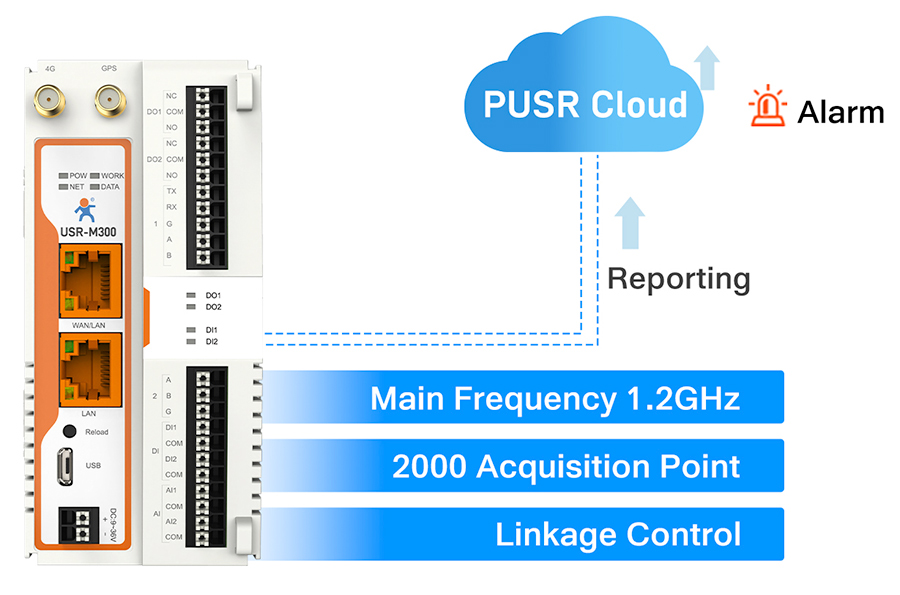Cellular gateway refer to hardware devices connected from one network environment to another, including communication gateways, protocol converters, remote terminal units, etc., which can be used in complex industrial environments. It can be used as a hub between field devices and system platforms in the industrial Internet of Things to achieve data interconnection and maximize the value of data.
As the most basic function of Cellular gateway, sensors, instruments, PLCs and other devices in the industrial field need to be connected to the gateway through the industrial bus interface (RS485, CAN), wireless interface and network interface, and the gateway can adapt to the communication protocol of field devices. Such as Modbus, Siemens S7 protocol, DLT645, CJT188, etc., read the data of the device and can issue control commands;The gateway can upload the collected data to the system platform through 4G/5G, industrial bus interface, network interface, etc.; Of course, the gateway itself can also have an I/O interface to meet the more complex control needs of the industrial field.
The gateway is like "a translator who is proficient in many languages", which can translate many different languages into the language that the platform can understand, so that the field device and the platform can understand what each other is saying and doing.
Data is priceless, and the lack of basic data can even lead to the failure of platform applications, so the internal storage of Cellular gateway is very important. The gateway can store the collected data in its own memory, which will not be lost in case of power failure, and form a dual backup with the platform, so that the platform can call the historical data at any time.When the 4G/5G base station has problems or is under maintenance, the platform loses contact with the site, and the gateway continues to collect and store data on site. After replying to the communication with the platform, the data can be actively uploaded to the platform from the moment of disconnection to ensure the integrity of the basic data of the platform, so that the platform can fully tap the application of data and bring value to customers.
"Cloud edge collaboration" has become a major trend in the Internet of Things. The platform decentralizes computing tasks and requires Cellular gateway to have edge computing functions.
In practical applications, the platform accesses a large number of devices, and the data concurrency is huge, which brings great pressure to the platform and network (especially 4G/5G tariff). Cellular gateway can process the field data according to the preset and upload the processing results to the platform; For some simple linkage control and alarm, edge computing can also be realized locally through logic programming.The real-time performance of control and alarm is greatly improved; Secondary development is also a kind of edge computing, such as cross-platform development and container APP development. The edge computing of Cellular gateway should be an open platform. Both debugging engineers and development engineers can realize their own edge computing needs.

The cost of manual on-site maintenance is sometimes higher than the cost of the equipment itself, so remote maintenance is essential.
After Cellular gateway is connected to the public network, the supporting debugging software should be able to remotely connect to the field gateway through the remote server, so that engineers can debug the field gateway or troubleshoot field problems in the office, and solve problems remotely immediately when problems are found, which greatly improves the operation efficiency. To truly achieve the goal of "winning thousands of miles away in the midst of strategizing".
Cellular gateway should also have software and hardware security encryption, wireless networking, high-performance chips, 4G routing, firewall and other functions, which will not be described in detail here.
With the rapid development of electronic communication, cloud platform, Internet of Things and other technologies, the development of urban informatization and industrial control are undergoing major changes and new breakthroughs. The city is gradually developing from automation and digitalization to intelligence, and the industrial manufacturing industry is gradually moving towards the industrial 4.0 era. The requirements for terminal sensing equipment are also changing from digitalization to intelligence.
(1) Smart city: Smart city is a big concept, including smart water, smart lamp poles, smart transportation, etc. The Internet of Things system is the core of building a smart city, and Cellular gateway is an indispensable part of the Internet of Things system.
(2) Smart factory: for smart factory and automation factory, the gateway is connected to various sensors, PLC and human-machine interface on site, and the site information is uploaded to the central control room platform to feed back the site production information in time.
(3) Energy Internet: In the power, gas, petrochemical and other energy-related industries, the equipment is scattered all over the country and needs centralized operation and maintenance. The industrial Internet of Things gateway is used to collect field instruments, sensors and other equipment and send them to the energy platform.

